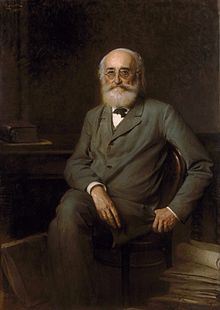Kálmán Tisza
|
Noble Kálmán Tisza de Borosjenő |
|
|---|---|
 |
|
| 9th Prime Minister of the Kingdom of Hungary | |
|
In office October 20, 1875 – March 13, 1890 |
|
| Monarch | Francis Joseph I |
| Preceded by | Béla Wenckheim |
| Succeeded by | Gyula Szapáry |
| Personal details | |
| Born |
December 16, 1830 Nagyvárad, Kingdom of Hungary |
| Died | March 23, 1902 (aged 71) Budapest, Hungary |
| Nationality | Hungarian |
| Political party |
Left Centre Liberal Party |
| Spouse(s) | Ilona Degenfeld-Schomburg |
| Relations | István Tisza |
Kálmán Tisza de Borosjenő (archaically English: Coloman Tisza, or Koloman Tisza; December 16, 1830 – March 23, 1902) was the Hungarian prime minister between 1875 and 1890. He is credited for the formation of a consolidated Magyar government, the foundation of the new Liberal Party (1875) and major economic reforms that would both save and eventually lead to a government with popular support. He is the longest-serving head of government in the history of Hungary.
At the age of 18, Kálmán Tisza witnessed one of the greatest reformations of the political arena in Hungarian history. Hungary changed from being a feudalistic government into a newly establish constitutional government that had many of the components of modern-day governments. Legislation such as Public Law III abolished the Royal Chancellery and the Residential Council and replacing them with a bicameral parliament (House of Lords and House of Representatives). Democratic seeds were also sown with Public Law V that allowed 6.5% of the population to vote (Janos 85). And finally the union of traditional Magyar lands under Public Law VI and VII allowed for a united Hungary. These powerful reforms led to a nationalist revolt that led to the overthrow of the Habsburg monarchs during the Hungarian Revolution of 1848.
With the defeat of the Hungarians during the rebellion, much, if not all, of the reforms were revoked and replaced with a military administration under Haynau. Though the counterrevolution ended the parliamentary style government of Hungary, it did not destroy the seeds that were planted by those reforms. During 1859 and 1860, after seeing the Hungarian popular support for the Italians during the Austro-Italian wars, Austria began to try new constitutional experiments in Hungary. During this period Kálmán Tisza was first elected into the newly formed government. Then, in 1867, Tisza took part, with Parliament, in negotiations with Emperor Franz Joseph I that led to the Ausgleich or the Compromise of 1867. The importance of this document is that it restored the "Constitutional integrity of Hungary" (Janos 90), with the exception over the powers of defense and foreign relations. These minor concessions by the Emperor soon collated and restored the powers, concerning internal affairs, back to the Hungarians. These concessions soon laid the path that allowed Tisza to rise to the position of Prime Minister. In 1875. he established the Liberal Party and was elected to the position of Prime Minister of Hungary. The efficiency of the government was quite weak and his actions during his 15-year reign mainly consisted of reforms of the government and the economy.
...
Wikipedia
